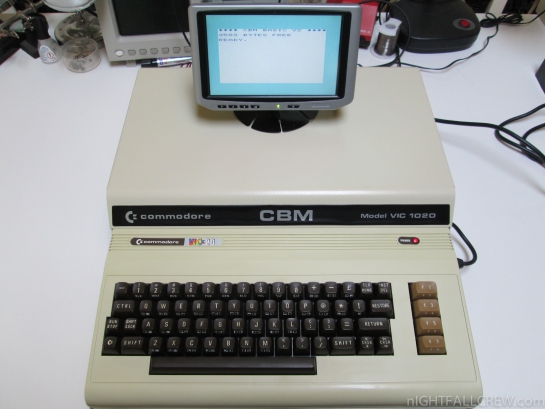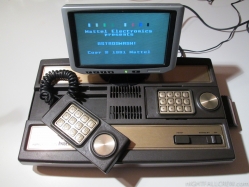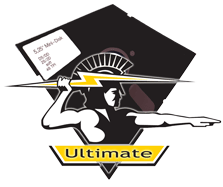I’m happy to share the photos of the day spent with Damiano (Manosoft) that besides being a good friend is also the father of the interface C64SD Infinity for Commodore 64/C16/VIC20.
We spent a pleasant day of old memories, we are watched and commented some demos for the Commodore 64 and we have completed the repair of the keyboard of his Commodore SX-64.
Thanks Damiano for making me visit and for giving me a lot of things that are now part of my collection.

Autopsy:
from Denial Wiki Homepage:
The VIC-1020 (known as the VC-1020 in Germany) expansion chassis is a large metal enclosure which provides the VIC-20 computer with six additional expansion slots for cartridges (five pointing upward and one lying horizontally and pointing toward an opening on the the back of the VIC-1020). The entire VIC-20 computer is placed into the VIC-1020 and a male edge connector on the 1020′s slot expansion board is mated with the VIC-20′s internal cartridge port. A monitor can be placed on top of the VIC-1020, giving the entire setup a PET computer-like appearance. Indeed, the black “CBM” label across the front of the VIC-1020′s casing is similar to that used on the the PET line of computers. The choice of sheet metal for this enclosure seems natural, as Commodore had a sheet metal fabrication plant for the production of office filing cabinets and desks.
The VIC-1020′s chassis has additional storage space which can be used for the computer’s power supply (a pass-through for the power supply is provided). There is also a metal clip on the underside of the lid which can hold the RF modulator.
Slot expanders such as this allowed the simultaneous use of several cartridges on a single VIC-20. This allowed features of utility cartridges (like the Programmer’s Aid cartridge) and RAM expanders to be combined. Unlike some other slot expanders, however, the VIC-1020 lacked switches to enable or disable individual cartridges – meaning cartridges had to be physically removed to disable them. This emphasizes what seems an apparent design flaw of the VIC-1020; the monitor needs to be lifted off the chassis and set aside to enable the user to open the lid and access the extra cartridge ports – a cumbersome process if repeated often.
source: sleepingelephant.com

Autopsy:
You can found Parts list and Schematics here
from wiki.intellivision.us Homepage:
The Intellivision directly generates composite video using the AY-3-8915 Color Processor and a set of resistors. This video gets fed to the ASTEC UM1285-8 video modulator for conversion to RF for display on a television set. It is possible to tap this composite video directly to avoid the distortion and static associated with RF modulation and demodulation. On older units, the RF modulator can decay rather noticeably, leading to very low quality video.
Typical composite video inputs have an input impedance of 75Ω. In contrast, the composite signal generated by the Intellivision has a very high output impedance. (We estimate the output impedance is around 2KΩ.) Tapping this output and feeding it directly into a typical composite monitor does not work. (It will work if your monitor has a “high impedance” input, but such monitors are atypical.) Thus, an amplifier/impedance matching circuit is necessary.
It is also possible to tap the audio the Intellivision generates. The audio output by the Intellivision is nearly directly suitable for feeding line-level inputs on most AV equipment. All that’s required is a coupling capacitor.
The modification should work equally well on all Intellivision variants, including the Intellivision 1, Intellivision 2, the various rebranded units (Sears, Tandy), and the later INTV releases.
source: wiki.intellivision.us
Kernel JiffyDos Installation and Keyboard Repair for my friend Damiano (manosoft.it). To repair the keyboard you must clean the contacts very well on the pcb.
Working Commodore SX-64 in cluster ;-D
Today a friend has donated to me some nice things. Thanks Damiano (Manosoft).
Things that have been donated:
- Commodore SX64 Manual.
- TV +4 Pong Clone.
- PCB Multi Kernel C64/C64C Switch.
- PCB Universal PLA Adapter.
- Atmel 27C512 PROM 70ns.
- Some DIMM Memory (256mb and 512mb)
- Mattel Intellivision.
- Mattel Intellivision Boxed Games:
- Football.
- Advanced Dungeons & Dragons.
- Skiing.
- Maze-A-Tron.
- Sea Battle.
- Tennis.
- Basketball.
 The Hires Color 7 Demo/Picture Show contains 32 images and utilises the Magica Driver with several Duce and Veto (C64 graphicians) pictures included.
The Hires Color 7 Demo/Picture Show contains 32 images and utilises the Magica Driver with several Duce and Veto (C64 graphicians) pictures included.
Download: Hires Color 7 Demo/Picture Show (1154)
source: plus4world.powweb.com
![C64 Game: Yie Ar Kung-Fu II +6DH [ntsc/pal] / Commando +2 ...](https://www.nightfallcrew.com/wp-content/uploads/2013/02/c64_13_02_2k13-300x225.png?76c919) Some new games (Cracked / Trained or Unrealeased) for Commodore 64 have been released from your favorites groups: Sos, Rubberland, Alpha Flight, Nostalgia and inZane.
Some new games (Cracked / Trained or Unrealeased) for Commodore 64 have been released from your favorites groups: Sos, Rubberland, Alpha Flight, Nostalgia and inZane.
Download:
source: csdb.dk
 This music disk of Laxity collects all the songs released during the event Crack Intro Music Competition 2013.
This music disk of Laxity collects all the songs released during the event Crack Intro Music Competition 2013.
Download: Top 50 of Crack Intro Music Competition 2013 (1026)
source: csdb.dk
 A new version of the firmware for the interface 1541 Ultimate II is released. This version runs only on the 1541 Ultimate II cartridge (new fpga).
A new version of the firmware for the interface 1541 Ultimate II is released. This version runs only on the 1541 Ultimate II cartridge (new fpga).
Version 2.6d includes some new features and fixes:
- FIXED: Ultimax mode forced now correctly implemented (solves issue with freeze and DMA load)
- FIXED: Updater now works on C128… (not all C128 issues are fixed)
- ADDED: Programmable cartrige emulation timing.
- IMPROVED: Some drive emulation enhancements.
Release notes:
- This version does *not* include SID, but it does include the Ultimate Audio module. Different builds may become available upon request.
- The internal copier is still in beta. It has been tested with some of my drives, but there might be drives out there that won’t work. Make sure you have an IEC link from the Ultimate to a real drive to use this function. (No need to have a link to the computer.) There is still no retry mechanism; sectors that failed to read correctly will not be re-read.
- The Kernal replacement function is critical when it comes to timing. Tested on two machines only. Might not work on all C128.
Download: 1541 Ultimate II Firmware v2.6d (1372)
source: 1541ultimate.net
 NAV, is a new file browser for the C64. NAV can use a mouse in Port 1, joystick in Port 2, or the keyboard. NAV can work with up to five drives and has been tested with the following drive types:
NAV, is a new file browser for the C64. NAV can use a mouse in Port 1, joystick in Port 2, or the keyboard. NAV can work with up to five drives and has been tested with the following drive types:
1541, 1571, 1581, uIEC, IDE64
Browsing through directories and disks is just point and click! Drives like the uIEC that can store gigabytes of software can be tedious and frustrating to navigate. NAV lets you easily work with D64/D71/D81/DNP/M2I disk images as well as “real” Commodore disks and the IDE64. Up to five drives at a time!
Just click a drive to browse it!Pressing the “@” key brings up a command line that acts just like the good ol’ DOS Wedge. In addition, there are a few additional commands that can be entered on the command line. Just type “@HELP” to get the complete list.
Changelog:
- More drive icons. The font has been improved, directory listings look better.
- NAV now displays the number of files on the disk.
- Lots of bug fixes.
- LOAD and RUN the CHANGES program to read the complete changelog. As before, type “@help” in NAV to get a full list of features.
- You can now choose from 12 different backgrounds. I copied most of these tiles from ones used in GEOS (thanks ShadowM).
- Unfortunately, NAV still does not work with the Final Cartridge III. Sorry. It seems as though there is a way to temporarily disable the FCIII to allow it to work with NAV… but I can’t figure it out… yet. Feel free to drop me a line if you think you can help.
Download: NAV v9.6 (D64 & PRG) (1352)
source: commodoreserver.com
 There are not a lot to say about this gadget, the photo speaks for itself. It’s a pillow that has the shape of a Commodore 64, simply a fantastic idea.
There are not a lot to say about this gadget, the photo speaks for itself. It’s a pillow that has the shape of a Commodore 64, simply a fantastic idea.
source: bieno64.blogspot.com.es




































































![C64 Game: Yie Ar Kung-Fu II +6DH [ntsc/pal] / Commando +2 ...](https://www.nightfallcrew.com/wp-content/uploads/2013/02/c64_13_02_2k13-300x225.png?76c919)

 A new version of the firmware for the interface 1541 Ultimate II is released. This version runs only on the 1541 Ultimate II cartridge (new fpga).
A new version of the firmware for the interface 1541 Ultimate II is released. This version runs only on the 1541 Ultimate II cartridge (new fpga).





Recent Comments